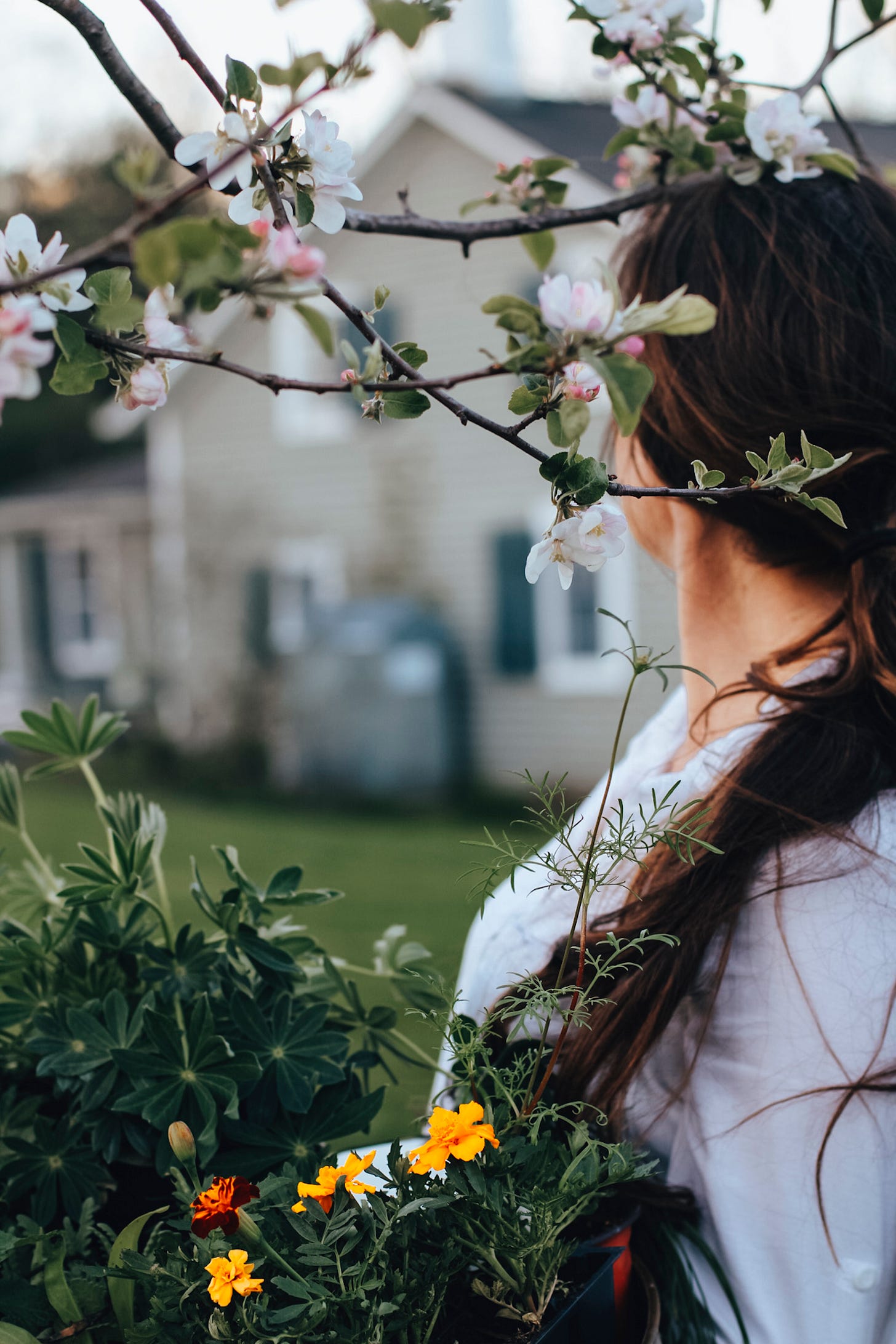Hi! It’s been a minute since I had time to sit down and write an actual piece. This is busy season on the farm for me and planting has me running from point A to B to C all day, every day. One of the major projects I’m just wrapping up are my fruit tree guild revisions. If you’re unfamiliar:
A guild is a permaculture term for a network or micro-ecosystem of plants that work together to support a main fruiting tree or crop.
Think companion planting but rather than just a pair, it’s a community. I am super passionate about this approach to growing food as it allows the grower to increase their abundance by growing upwards over horizontally, it mimics Mother Nature’s approach to plant diversity and density, and it naturally helps to reduce pest and disease pressure among many other benefits. This methodology also invites birds, insects, and small wildlife to take up residence within the woody and dense plants.
I had planted guilds years ago around my existing 20+ fruiting trees on the property; I raise apples, pears, apricots, plums, Russian pomegranate, persimmon, fig, quince, jujube, peaches, medlar, cherry, and even some newly-added cold hardy citrus. This year it was time to expand those communities on my farm by connecting them together for a food forest aesthetic.
In a guild, each main tree or shrub receives a specific set of partners that perform certain functions. There are a total of seven members in a guild:
The main fruiting shrub or tree: think the apple tree for example.
The pollinator attractor: plants that draw in beneficial pollinators and insects like lavender.
Pest repellers like yarrow, chives or garlic that deter deer or rabbit browsing, Japanese beetles or even some forms of disease in some cases.
Accumulators are nutrient-mining plants that pull elements upward from deep within the soil’s sublayers and make it more readily available to nearby plants. An example is comfrey.
Nitrogen fixers help to add nitrogen to the soil such as clover, beans or peas and lupine. Often main fruiting trees or shrubs are heavy nitrogen feeders so having a friend nearby is helpful!
Mulchers are companion plants that can be chopped, dropped, and then decay in place to return organic matter and nutrients to the soil. Comfrey and borage are amazing examples.
The weed suppressors have the heavy task of growing densely and quickly to crowd out weeds and other unwanted growth.
When we create a guild or ecosystem of plants we’re designing the way nature intended. Where in a forest or natural setting are trees grown with no plants surrounding them? Instead there are layers or levels of growth that interact and live with one another. Even the juglone-, toxin-producing walnut is surrounding by happily growing cane berries. There are partners for everyone.

Because guild ecosystems contain plants that perform functions, labor and pressure on the part of the grower is greatly reduced. Rather than pulling excessive weeds, the weed suppression plants assist the grower. While coddling moths and apple maggots are a headache for any organic grower, pest deterrent plants can help reduce populations. Early season blooming flowers like daffodils attract pollinators to the area so that when the apple blossoms are open and ready for fertilization, pollinators are already aware of the area. Guild members can have stacked functions as well, meaning comfrey acts as a chop-and-drop mulching member while accumulating nutrients in the soil simultaneously. Yarrow repels some critters, attracts pollinators, and recent studies have shown it may mine nutrients in the soil as well.
Guild members differ by species of fruiting tree so an apple tree will require differing partners in its ecosystem than a fig tree. The best way to identify these guild members is to look at the pests or challenges that may affect your main fruiting crop in your climate. Then research and discover what plants can help to deter that problem. If your main fruiting tree or shrub requires a lot of nitrogen, phosphorous or even magnesium, what companion plants can help to fix those as soil inputs? Of course there are general guild “recipes” and guides too that simply may need tweaking based on your geographical locale. You can find guild combinations by fruiting tree type in my book The Sustainable Homestead in the orchard chapter.
Guilds begin to mimic the look and function of forests when we start thinking in layers as well. In a forest we have the overstory, mid-story, understory, groundcover, and vining plants. When we combine this understanding of vertical growth with guild companion member utility we begin to formulate food forest systems. More on that to come. ;)
Thank you so much for reading.






Thank you for sharing!
Thanks for this article! We have , what I call, a postage stamp Orchard. It is inhabited by 9 fruit trees- pear,peach, cherry, 2 apples, plum, an Asian x native cross persimmon and quince.We’ve practiced Stinzen Planten for 10 years in this 20x60 area. I was making out the fall bulb order when I ran across your piece. I do not mow that area until June. I will be interested to learn about other plants to add to the understory. I’m 71 years old and I try to learn something new every day. You filled that niche for me today!